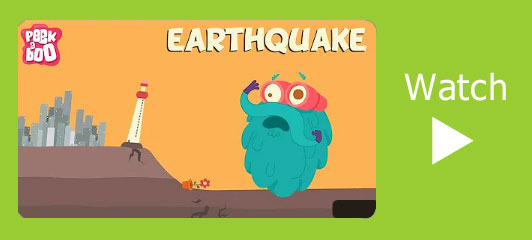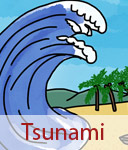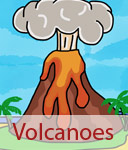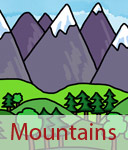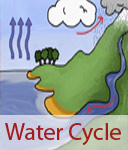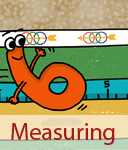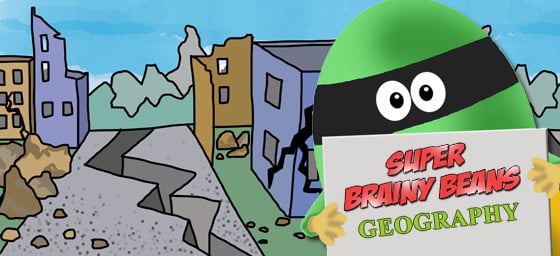

Earthquake facts
for kids
Earthquakes facts for kids learning in KS2 at Primary School. Homework help with the what an earthquake is and how they happen. Read about the impact of earthquakes on the environment.
What is an earthquake and how do they happen?
An earthquake is a sudden release of energy inside the Earth that makes the ground tremble and shake.
The Earth’s outer layer, called the crust, isn’t just one solid piece. It is made up of giant puzzle pieces called tectonic plates. These plates are always moving, but very slowly—sometimes only a few centimetres each year! Where the plates meet, they can slide past, crash into, or pull away from each other.
As the plates move, the rocks at the edges can get stuck. Imagine trying to push two rough blocks of wood against each other—the edges grip until suddenly they snap free. The same thing happens underground. When the rock is squeezed, stretched, or jammed, the pressure builds up. Eventually, the rock breaks or slips suddenly, releasing a huge burst of energy. This release is what makes the ground shake—that’s the earthquake!
The place deep underground where the rock actually breaks is called the focus. The point directly above it on the Earth’s surface is called the epicentre. This is usually where the earthquake feels the strongest.
Sometimes, not all of the energy is released at once. Smaller bursts follow the main earthquake. These are called aftershocks, and they can go on for days, weeks, or even months after the first big shake.
 KD Find out!
KD Find out!Earthquakes are events where the ground shakes. Find out more facts.
 Weather WizKids
Weather WizKidsA tsunami is a large ocean wave usually caused by an underwater earthquake or a volcanic explosion.
Where do earthquakes occur?
Earthquakes mostly happen when two tectonic plates rub, crash, or slide past each other. This is why earthquakes are usually found along the edges of tectonic plates.
One of the most famous earthquake zones is called the Ring of Fire. This is the edge of the massive tectonic plate that sits under the Pacific Ocean. The Ring of Fire forms a huge horseshoe-shaped belt that stretches around countries like Japan, New Zealand, the west coast of North and South America, and many islands in between. This area is incredibly active—around 90% of all earthquakes and about 75% of the world’s active volcanoes happen here. That’s why the Ring of Fire is sometimes called the most dangerous place on Earth for earthquakes and volcanoes.
High-risk countries
Scientists who study earthquakes have also mapped out the most at-risk countries in the world. There are 15 countries where earthquakes are especially dangerous because of the way the plates meet and the number of people living there. Some of the most earthquake-prone countries include:
- Japan, where powerful earthquakes and tsunamis are common.
- China, which has a long history of deadly earthquakes.
- The Philippines, where the land is squeezed between several tectonic plates.
- Iran, which sits on a very active fault line.
- Indonesia, which is right in the middle of the Ring of Fire and has both earthquakes and volcanoes.
Other countries at risk include places like Turkey, Mexico, Nepal, Pakistan, and India. In these regions, earthquakes can cause huge amounts of damage because cities, towns, and villages are built very close to the fault lines.
This is why scientists keep studying where earthquakes happen—so people can prepare and build safer homes, schools, and cities in these risky areas.
 Earthquake Track
Earthquake TrackSee where today's biggest earthquakes are with this live map.
How are earthquakes measured?
Earthquakes are measured using a seismometer which detects vibrations in the earth. The earthquake's size and strength are then measured using the Richter scale. Earthquakes can last anywhere between a few seconds for the smaller ones to a few minutes for the larger ones.
It is impossible to predict earthquakes. Seismometers only detect earthquakes when they are happening. However, after an earthquake, there are aftershocks (a series of smaller earthquakes). This is the only time when warnings can be given out to populated areas.
Scientists can make earthquake predictions. This is an estimate of where and when earthquakes might occur looking at previous data. One example is in California and the San Andreas fault line. Experts predict that there will be a destructive earthquake here in the next 30 years. This is because the two plates are moving at a rate of 30mm and 50mm a year. This may not seem much but the Pacific plate is moving faster and pressure is building under the earth's surface. The last time it had pressure like this was in 1906 when an earthquake with a magnitude of 7.8 hit. This is what makes scientists believe that there is another earthquake due soon.
Richter scale
| Richter Scale | Description | Frequency (per year) |
|---|---|---|
| 0 | Not felt by people | 800,000 |
| 1 | Plates and windows start to rattle | |
| 2 | Small objects move, liquid in glasses move around | |
| 3 | Ceiling lights swing, books fall off shelves | |
| 4 | Walls crack | 30,000 |
| 5 | Furniture moves | 1,400 |
| 6 | Some weaker buildings collapse | 100 |
| 7 | Many buildings destroyed | 15 |
| 8 | Total destruction of buildings, bridges and roads over several hundred miles | 1 every 5-10 years |
| 9 | Devastation in areas over thousands of miles | |
| 10 | Never recorded |
What impact do earthquakes have?
Earthquakes can cause huge problems for people, animals, and the places they live. The most obvious impact is that earthquakes can lead to injuries or deaths when buildings, bridges, or roads collapse. Animals can also be hurt or lose their homes when the land is shaken apart.
Impact on people
- Injuries and deaths – Collapsing buildings, bridges, and roads can injure or kill people. The number of deaths in an earthquake can depend on how well prepared a country is.
- Animals affected – Pets, farm animals, and wildlife can be hurt or lose their homes.
- Destroyed homes, schools & hospitals – Families may lose their houses, children may not be able to go to school, and hospitals may be too damaged to treat the injured. Earthquakes also leave thousands of people homeless. With no roof over their heads, families may have to sleep outside in tents or temporary shelters.
- Poorly built structures collapse – In some places, buildings are specially designed to bend and sway a little without breaking, which helps them survive a strong shake. In poorer countries, where buildings may be poorly built, they are much more likely to collapse, leading to many more injuries and deaths.
- Transport problems – Roads, railways, and airports may be damaged, making it difficult for rescuers to reach survivors.
- Lost communication – Phones and the internet may stop working, so people can’t contact loved ones.
- No power – Electricity may be cut off, leaving whole areas without electricity.
- Gas explosions and fires – Broken gas pipes can cause explosions, and fires can spread quickly through damaged towns and cities. These fires often make the destruction even worse.
- No clean water - Clean water supplies may also be cut off, leaving areas without clean drinking water. Without this people don't have proper sanitation and diseases can spread quickly.
- Lack of food – Supplies can run out, making survival difficult
- Looting – Some people turn to looting—taking food, water, or goods from shops and homes—because there aren’t enough supplies to go around. This can make life even harder for survivors and slow down recovery.
- High costs – The cost of repairing the damage is enormous, sometimes billions of pounds. Whole communities may need to be rebuilt, which can take years. Many businesses are destroyed, leaving people without jobs and money.
- Loss of jobs – Shops, offices, and factories may be destroyed, leaving people without work.
- Support aid - Despite all this devastation, communities often come together to help one another, and aid from other countries can provide food, water, medicine, and money to rebuild. Earthquakes are powerful and destructive, but people’s strength and teamwork after a disaster often shine through.
Impact on the environment
- Shaken landscapes – Land can split, crack, or shift, changing the natural scenery.
- Wildlife habitats destroyed – Forests, rivers, and caves can collapse, leaving animals without shelter or food.
- Tsunamis – Underwater earthquakes can trigger giant ocean waves that flood coastal areas.
- Secondary disasters – Earthquakes can spark landslides, avalanches, and fires.
- Polluted water supplies – Broken pipes and damaged sewers can contaminate rivers and lakes.
- Farmland lost – Fields may be destroyed by landslides or flooding, making it hard for farmers to grow food.
- Long-term changes – Mountains can rise, rivers may change course, and entire landscapes may be reshaped.
 Stop Disasters Game
Stop Disasters GameLearn the risks posed by natural hazards and manage your resources. Build schools, hospitals, housing and defences to protect the local population.
Major Earthquakes
A major earthquake is one that measures magnitude 7.0 or higher. About 15 such quakes happen each year, mostly along tectonic plate boundaries. Many occur in remote areas where few people live—and that’s why you might not hear about them. Unfortunately, when these earthquakes strike regions where people live, they can be devastating. Worldwide, tens of thousands of people die every year because of earthquakes.
Here are some of the most powerful and destructive earthquakes in history:
1. Chile – May 1960 (Magnitude 9.5)
The strongest earthquake ever recorded. It caused landslides, destroyed homes, and triggered a massive tsunami that reached as far as Hawaii, Japan, and the Philippines. Over 1,655 people died, and 2 million were left homeless.
2. Sumatra, Indonesia – December 2004 (Magnitude 9.1)
Lasted around 10 minutes, the longest earthquake ever recorded. It caused a giant tsunami up to 30m high, which swept across the Indian Ocean, killing around 230,000 people in 14 countries. Millions lost their homes.
3. Japan – March 2011 (Magnitude 9.0)
Known as the Great East Japan Earthquake, it caused a devastating tsunami. Nearly 16,000 people were killed, and whole towns were washed away. It also damaged the Fukushima nuclear power plant, leading to a nuclear disaster.
4. Chile (Maule) – February 2010 (Magnitude 8.8)
This powerful quake lasted over 3 minutes and triggered a tsunami. More than 500 people died, and about 370,000 buildings were damaged or destroyed.
5. Indonesia (Nias) – March 2005 (Magnitude 8.6)
Struck just months after the 2004 tsunami. It caused heavy damage on Nias Island and killed hundreds of people, with thousands left homeless.
6. Sichuan, China – May 2008 (Magnitude 7.9)
One of the most deadly quakes of the 21st century. Around 69,000 people died, and more than 5 million were left homeless. Many schools collapsed, leading to huge loss of life among children.
7. Turkey–Syria – February 2023 (Magnitude 7.8)
A massive quake that struck a large region. Over 59,000 people died, and 200,000+ buildings were destroyed. Millions were left without homes, making it one of the deadliest disasters in modern times.
8. Myanmar – March 2025 (Magnitude 7.7–7.9)
A very recent earthquake that killed more than 5,400 people. It caused widespread destruction in a country already facing conflict, making rescue efforts very difficult.
9. Japan (Noto Peninsula) – January 2024 (Magnitude 7.6)
Over 650 people died, and thousands of homes were destroyed or badly damaged. The quake caused fires, landslides, and left many villages cut off.
8. India (Gujarat) – January 2001 (Magnitude 7.7)
Around 20,000 people died, and 600,000 lost their homes. The city of Bhuj was badly damaged, and many ancient buildings collapsed.
9. Pakistan (Kashmir) – October 2005 (Magnitude 7.6)
One of the deadliest in South Asia. Around 80,000 people died, mostly because homes and schools were poorly built and collapsed.
10. Indonesia (Sulawesi) – September 2018 (Magnitude 7.5)
Triggered a tsunami and liquefaction (when the ground turns to liquid mud). Around 4,300 people died, and 68,000 buildings were destroyed.
11. Haiti – January 2010 (Magnitude 7.0)
One of the most tragic quakes in recent memory. Around 316,000 people died, 80,000 buildings collapsed, and millions were left homeless. The capital city, Port-au-Prince, was devastated.
12. Haiti – August 2021 (Magnitude 7.2)
Another major quake struck Haiti, killing about 2,200 people and destroying 13,000 buildings. The country was already struggling to recover from the 2010 disaster.
13. Iran – November 2017 (Magnitude 7.3)
Hit near the Iraq border, killing around 400 people and injuring thousands.
14. Tibet, China – January 2025 (Magnitude 7.1)
A deadly quake that killed at least 126 people (possibly up to 400). Landslides and avalanches made rescue difficult, especially in remote mountain areas.
15. Vanuatu – December 2024 (Magnitude 7.3)
This island nation was struck by a powerful quake and tsunami, killing 14 people and damaging homes in the capital, Port Vila.
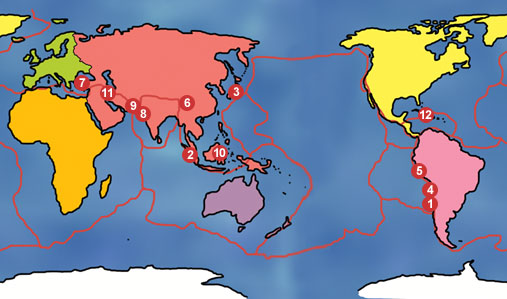
 Disaster Master
Disaster MasterHelp the Heroes in a disaster. Tornados, earthquakes, tsunamis and more.
 Natural History Museum - London
Natural History Museum - LondonVisit the 'Red Zone' to see close up what earthquakes do and the devastation it leaves behind.

 BBC Bitesize: Earthquakes
BBC Bitesize: Earthquakes